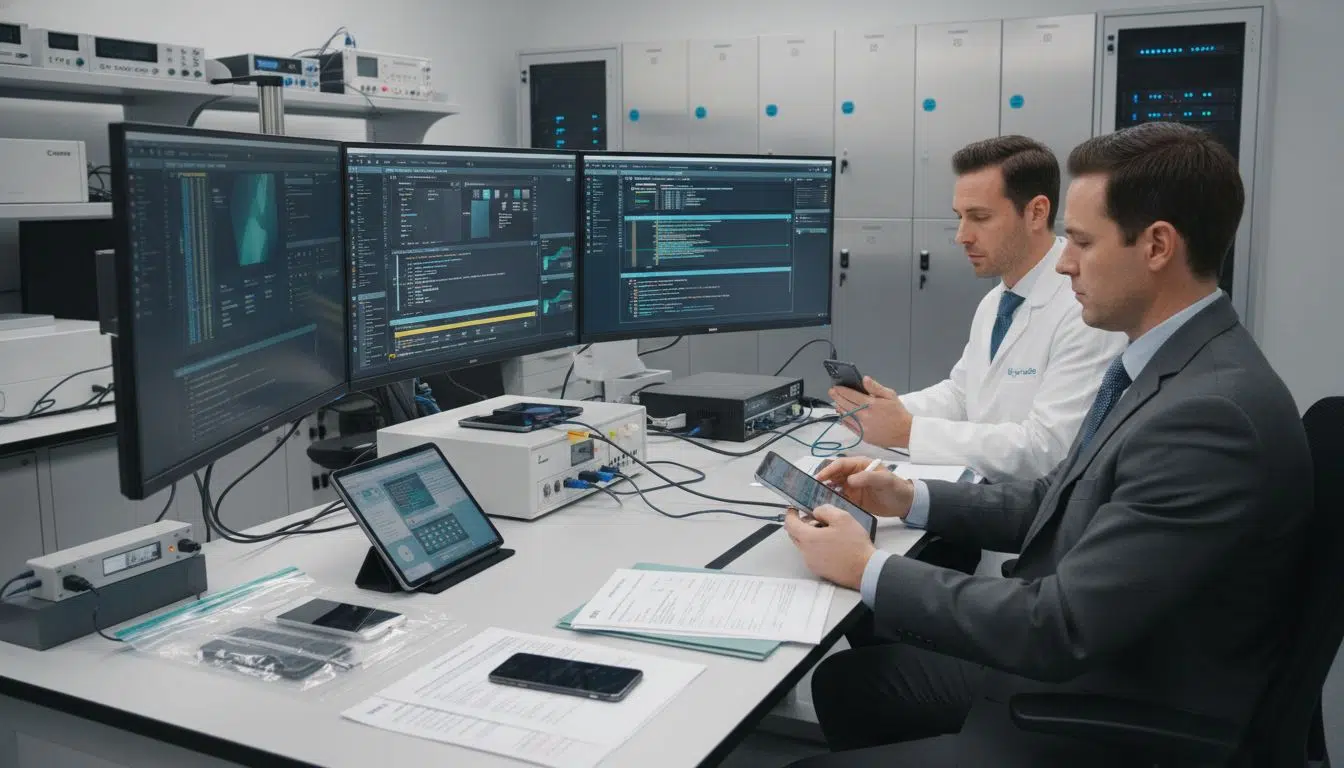More than 97 percent of teenagers in the United States now own a smartphone, and most of these devices run on Apple’s iOS platform. With so much sensitive information stored in iPhones and iPads, the need for skilled iOS digital forensics has never been more urgent. Experts are tasked with extracting critical evidence from encrypted and highly secure devices while upholding strict legal and technical standards, ensuring every detail can stand up in court.
Table of Contents
- Defining iOS Digital Forensics and Its Scope
- Core Methods for Forensic Data Acquisition
- Essential Tools for iOS Evidence Analysis
- Legal Protocols and Evidence Admissibility
- Challenges and Best Practices in iOS Forensics
Key Takeaways
| Point | Details |
|---|---|
| iOS Digital Forensics Scope | Focuses on comprehensive investigation of Apple’s iOS, involving detailed data recovery and analysis from devices like iPhones and iPads. |
| Data Acquisition Methods | Utilizes techniques such as logical, physical, and advanced extractions, each with distinct advantages and limitations regarding data access and recovery. |
| Legal Protocols | Adherence to strict legal frameworks is essential for evidence admissibility, emphasizing the importance of maintaining the chain of custody and proper documentation. |
| Current Challenges | Investigators must navigate evolving encryption technologies and privacy enhancements, requiring continuous learning and adaptation of forensic methodologies. |
Defining iOS Digital Forensics and Its Scope
Digital forensics represents a sophisticated investigative discipline focused on extracting, preserving, and analysing digital evidence from electronic devices. According to research from the Office of Justice Programs, iOS digital forensics specifically concentrates on investigating Apple’s mobile operating system ecosystem, encompassing comprehensive data recovery from iPhones, iPads, and related iOS devices.
The scope of iOS digital forensics extends far beyond basic data retrieval. Mobile Forensics Investigations: Digital Evidence Capture From Mobile Phones highlights critical examination areas including:
- System logs and application metadata
- Communication records and message histories
- Location tracking and geospatial information
- Deleted files and temporary cache data
- Encrypted application databases
Forensic experts must navigate complex technical challenges while maintaining rigorous legal standards. This requires specialized methodological approaches that preserve data integrity and ensure admissibility within legal proceedings. Practitioners must employ advanced techniques that can penetrate device security measures without compromising potential evidence, making iOS digital forensics a nuanced and technically demanding discipline.
Ultimately, iOS digital forensics serves multiple critical domains including criminal investigations, corporate compliance, intellectual property protection, and civil litigation support. By systematically extracting and analysing digital artifacts, forensic professionals provide invaluable insights that can uncover crucial evidence hidden within mobile devices.
Core Methods for Forensic Data Acquisition
Forensic data acquisition represents a critical process in digital investigations, involving systematic methods for extracting electronic evidence from iOS devices. According to research from the Office of Justice Programs, forensic experts employ multiple sophisticated techniques to recover data while maintaining legal and technical integrity.
Three primary methods of iOS device data acquisition stand out:
Here’s a comparison of the main iOS forensic data acquisition methods:
| Acquisition Method | Key Characteristics | Advantages | Limitations |
|---|---|---|---|
| Logical Extraction | Uses standard interfaces User data |
Fast Non-invasive |
Limited to accessible files |
| Physical Extraction | Bit-by-bit copy Full storage capture |
Recovers deleted data Comprehensive |
May require device unlocking Risk of data loss |
| Advanced Techniques | Chip-off JTAG Hardware-level |
Access to locked devices Bypasses some security |
Technically complex Device damage risk |
- Logical Extraction: Retrieves accessible data through standard device interfaces
- Physical Extraction: Creates comprehensive bit-by-bit storage copies
- Advanced Techniques: Includes specialized approaches like chip-off and JTAG for challenging scenarios
7 Essential Digital Forensic Techniques for Success underscores the importance of selecting appropriate extraction methods based on device condition and investigation requirements. Each technique offers unique advantages and potential limitations, requiring forensic professionals to make strategic decisions that preserve evidence authenticity.
Ensuring legal admissibility remains paramount in digital forensics. Practitioners must rigorously follow established protocols that guarantee data integrity and comply with judicial standards. This involves using validated forensic tools, documenting extraction processes meticulously, and maintaining verifiable chain of custody. By adhering to these principles, digital forensic experts transform raw electronic data into credible, court-acceptable evidence that can effectively support legal proceedings.
Essential Tools for iOS Evidence Analysis
Digital forensic tools represent the critical technological backbone of iOS evidence analysis, enabling investigators to navigate the complex landscape of Apple’s sophisticated device ecosystem. According to research from the Office of Justice Programs, these specialized tools must possess advanced capabilities to penetrate iOS encryption and extract meaningful digital evidence.
Key characteristics of effective iOS forensic tools include:
- Compatibility with multiple iOS versions
- Advanced decryption capabilities
- Support for comprehensive data extraction
- Ability to handle encrypted and deleted data
- Forensically sound evidence preservation mechanisms
8 Essential Mobile Forensics Tools List for Legal Experts highlights the importance of selecting tools that can reliably recover critical digital artifacts while maintaining strict legal admissibility standards. Professional-grade forensic software must continuously adapt to Apple’s evolving security architectures, ensuring investigators can access crucial evidence across diverse device generations.
Forensic practitioners must prioritize tools that provide comprehensive analysis capabilities, including advanced data reconstruction, metadata examination, and detailed artifact tracking. By leveraging sophisticated forensic technologies, digital investigators can transform raw device data into compelling, court-acceptable evidence that supports critical legal and investigative objectives.
Legal Protocols and Evidence Admissibility
Digital evidence admissibility represents a critical intersection between technological forensic practices and legal standards. According to research from the National Institute of Justice, iOS forensic investigations must meticulously adhere to established legal protocols to ensure the reliability and acceptance of digital evidence in judicial proceedings.
Key legal requirements for iOS digital evidence include:
- Maintaining comprehensive chain of custody
- Documenting forensic methodologies
- Preserving original device data
- Ensuring verifiable evidence extraction techniques
- Preventing contamination of digital artifacts
Understanding Chain of Custody Procedures in Law emphasizes the paramount importance of rigorous documentation and systematic evidence handling. Forensic professionals must demonstrate that digital evidence has been collected, processed, and stored using scientifically validated methods that prevent tampering or unauthorized modifications.
Courts evaluate digital evidence based on its relevance, reliability, and authenticity. This requires forensic experts to utilize standardized tools, maintain meticulous records, and be prepared to explain their investigative processes in detail. By following stringent legal protocols, digital forensics practitioners transform raw technological data into credible, legally admissible evidence that can withstand intense judicial scrutiny.
Challenges and Best Practices in iOS Forensics
iOS forensic investigations face increasingly complex technological barriers as Apple continues to enhance device security and privacy protections. According to research from digital forensics experts, investigators must continuously adapt their methodologies to navigate the sophisticated encryption and data protection mechanisms embedded within modern iOS devices.
Key challenges in contemporary iOS forensics include:
- Rapidly evolving device encryption technologies
- Enhanced privacy features blocking traditional extraction methods
- Sophisticated cloud data synchronization
- Increasingly complex authentication mechanisms
- Advanced hardware-level security implementations
Chanllenges in digital forensics investigations into modern mobile devices highlights the critical need for forensic professionals to maintain continuous learning and technological agility. Best practices demand a proactive approach that combines cutting-edge technical skills, legal compliance, and strategic problem-solving techniques.
Successful iOS forensic practitioners must invest in ongoing training, develop sophisticated decryption techniques, and maintain a network of collaborative expertise. By anticipating technological changes, maintaining rigorous documentation, and employing adaptive forensic strategies, investigators can effectively overcome the complex challenges presented by Apple’s increasingly secure device ecosystem.
Mastering iOS Digital Forensics with Expert Support
Navigating the complex challenges of iOS digital forensics requires more than just technical know-how. Whether you are dealing with encrypted data, extracting evidence while preserving chain of custody, or analysing sophisticated device logs, the need for precise and legally admissible results can be overwhelming. Key aspects such as selecting the right acquisition methods—logical, physical or advanced chip-off techniques—and using forensically sound tools are critical to uncovering hidden evidence without risking data loss or contamination.
At Computer Forensics Lab, we understand these pains and provide tailored solutions to meet your digital investigation needs. Our team specialises in comprehensive Digital Forensics Examination services that cover every step from data extraction to detailed evidence analysis. Supported by expert witness reporting and strict adherence to legal protocols, we empower legal professionals, businesses and law enforcement with actionable insights. Do not let technical barriers or legal complexities delay your case. Visit Computer Forensics Lab or explore our Digital Forensic Investigation offerings today to ensure your iOS evidence is handled expertly and ready for court.
Frequently Asked Questions
What is iOS digital forensics?
Digital forensics in the context of iOS refers to the investigation and analysis of data from Apple’s mobile operating systems, such as iPhones and iPads. It involves extracting, preserving, and analyzing digital evidence to support criminal investigations or legal proceedings.
What are the primary methods of forensic data acquisition from iOS devices?
The main methods for forensic data acquisition from iOS devices include logical extraction, physical extraction, and advanced techniques such as chip-off and JTAG. Each method has distinct characteristics, advantages, and limitations, making them suitable for different investigation scenarios.
Why is maintaining legal admissibility important in iOS digital forensics?
Maintaining legal admissibility is crucial because digital evidence must meet specific legal standards to be accepted in court. This includes ensuring the integrity of the data, following proper chain of custody procedures, and using verified forensic methods during data extraction and analysis.
What challenges do forensic investigators face when working with iOS devices?
Investigators face challenges such as rapidly evolving encryption technologies, enhanced privacy features that obstruct traditional extraction methods, and complex authentication mechanisms. These challenges require continuous learning and adaptation of forensic methods to successfully retrieve and analyze digital evidence.

